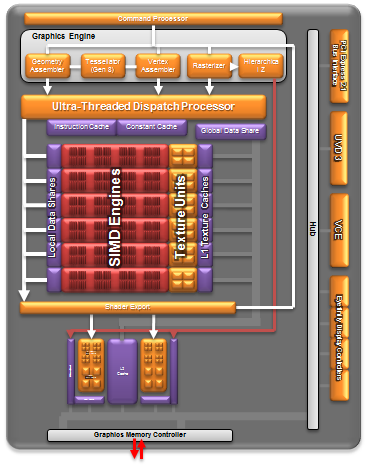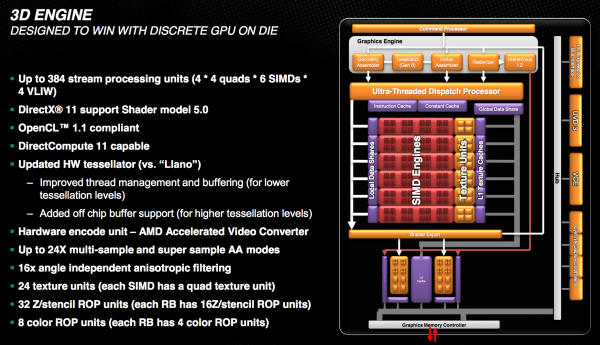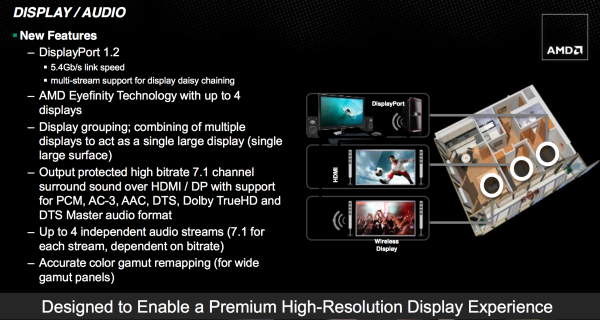The AMD Trinity Review (A10-4600M): A New Hope
by Jarred Walton on May 15, 2012 12:00 AM ESTImproved Turbo
Trinity features a much improved version of AMD's Turbo Core technology compared to Llano. First and foremost, both CPU and GPU turbo are now supported. In Llano only the CPU cores could turbo up if there was additional TDP headroom available, while the GPU cores ran no higher than their max specified frequency. In Trinity, if the CPU cores aren't using all of their allocated TDP but the GPU is under heavy load, it can exceed its typical max frequency to capitalize on the available TDP. The same obviously works in reverse.
Under the hood, the microcontroller that monitors all power consumption within the APU is much more capable. In Llano, the Turbo Core microcontroller looked at activity on the CPU/GPU and performed a static allocation of power based on this data. In Trinity, AMD implemented a physics based thermal calculation model using fast transforms. The model takes power and translates it into a dynamic temperature calculation. Power is still estimated based on workload, which AMD claims has less than a 1% error rate, but the new model gets accurate temperatures from those estimations. The thermal model delivers accuracy at or below 2C, in real time. Having more accurate thermal data allows the turbo microcontroller to respond quicker, which should allow for frequencies to scale up and down more effectively.
At the end of the day this should improve performance, although it's difficult to compare directly to Llano since so much has changed between the two APUs. Just as with Llano, AMD specifies nominal and max turbo frequencies for the Trinity CPU/GPU.
A Beefy Set of Interconnects
The holy grail for AMD (and Intel for that matter) is a single piece of silicon with CPU and GPU style cores that coexist harmoniously, each doing what they do best. We're not quite there yet, but in pursuit of that goal it's important to have tons of bandwidth available on chip.
Trinity still features two 64-bit DDR3 memory controllers with support for up to DDR3-1866 speeds. The controllers add support for 1.25V memory. Notebook bound Trinities (Socket FS1r2 and Socket FP2) support up to 32GB of memory, while the desktop variants (Socket FM2) can handle up to 64GB.
Hyper Transport is gone as an external interconnect, leaving only PCIe for off-chip IO. The Fusion Control Link is a 128-bit (each direction) interface giving off-chip IO devices access to system memory. Trinity also features a 256-bit (in each direction, per memory channel) Radeon Memory Bus (RMB) direct access to the DRAM controllers. The excessive width of this bus likely implies that it's also used for CPU/GPU communication as well.
IOMMU v2 is also supported by Trinity, giving supported discrete GPUs (e.g. Tahiti) access to the CPU's virtual memory. In Llano, you used to take data from disk, copy it to memory, then copy it from the CPU's address space to pinned memory that's accessible by the GPU, then the GPU gets it and brings it into its frame buffer. By having access to the CPU's virtual address space now the data goes from disk, to memory, then directly to the GPU's memory—you skip that intermediate mem to mem copy. Eventually we'll get to the point where there's truly one unified address space, but steps like these are what will get us there.
The Trinity GPU
Trinity's GPU is probably the most well understood part of the chip, seeing as how its basically a cut down Cayman from AMD's Northern Islands family. The VLIW4 design features 6 SIMD engines, each with 16 VLIW4 arrays, for a total of up to 384 cores. The A10 SKUs get 384 cores while the lower end A8 and A6 parts get 256 and 192, respectively. FP64 is supported but at 1/16 the FP32 rate.

As AMD never released any low-end Northern Islands VLIW4 parts, Trinity's GPU is a bit unique. It technically has fewer cores than Llano's GPU, but as we saw with AMD's transition from VLIW5 to VLIW4, the loss didn't really impact performance but rather drove up efficiency. Remember that most of the time that 5th unit in AMD's VLIW5 architectures went unused.
The design features 24 texture units and 8 ROPs, in line with what you'd expect from what's effectively 1/4 of a Cayman/Radeon HD 6970. Clock speeds are obviously lower than a full blown Cayman, but not by a ton. Trinity's GPU runs at a normal maximum of 497MHz and can turbo up as high as 686MHz.
Trinity includes AMD's HD Media Accelerator, which includes accelerated video decode (UVD3) and encode components (VCE). Trinity borrows Graphics Core Next's Video Codec Engine (VCE) and is actually functional in the hardware/software we have here today. Don't get too excited though; the VCE enabled software we have today won't take advantage of the identical hardware in discrete GCN GPUs. AMD tells us this is purely a matter of having the resources to prioritize Trinity first, and that discrete GPU VCE support is coming.















271 Comments
View All Comments
Beenthere - Tuesday, May 15, 2012 - link
Many students game on laptops and that's a large market segment with many people desiring portability by necessity these days.aliasfox - Tuesday, May 15, 2012 - link
Your average kid going into undergrad who doesn't care enough to spend more than $1k (or more than $700) for a computer will be pleasantly surprised when he/she fires up some random game - and releasing these machines right now is perfect timing to get product on the shelves for college back-to-school season.It's really all about 'good enough' on SC2 or Portal or whatever else people will pick up for a few hours a week. They don't care about 100 fps at insane external monitor resolutions with megapixels worth of textures, but if they can get >20-30 fps at 768p or 900p on whatever they might throw at it, they're happy enough.
I used to be of them.
mikato - Wednesday, May 16, 2012 - link
Me too. I played Quake 3 on an 8MB video card for quite a while on my desktop and everything worked well enough for me to kick butt with the rail gun :) It was great to play for a few minutes or an hour to unwind a bit.Caltek9 - Tuesday, May 15, 2012 - link
jwcalla,I'm actually totally interested in gaming on a lower-end laptop right now, and am trying to decide whether to wait for Trinity or not. I'm going to grad school (undergrad and building gaming towers was many years and 2 children ago), and need a light laptop with good battery that I can play recent games on (Diablo III, Kingdoms of Amalur, Saints Row the Third, Borderlands). The reason the Trinity setup is intriguing to me is because if the GPU works out, I can get (supposedly/hopefully) a very slim laptop that can do this, instead of a heavier one. I'll be going to grad school in Europe, and every pound I can shave off before I travel is a good thing! I've been a console gamer for far too long (since abandoning the PC after undergrad), so I'm used to not having the best looking graphics. As long as it can play a game smoothly, and at decent graphical settings, I'm fine with that.
I get a bit sad when seeing the Trinity CPU numbers, but keep trying to convince myself that it won't matter to me, since I'll mainly be typing papers, and surfing the Internet, and not transcoding anything with gaming on the side. I'm writing this on an Intel-based Mac, so I'm not a fanboy of either AMD.
Bottom Line: I want cheap, light, good battery, and the ability to play recent games at medium settings. Trinity seems to be able to do this better than Ivy Bridge, at least in these early reviews.
SIDE NOTE: Until I see an actual laptop with Trinity in the wild, this is my current choice for a replacement laptop (Sager NP6110/Clevo W110ER): http://www.xoticpc.com/sager-np6110-clevo-w110er-p...
I'm a bit worried about the screen and keyboard sizes for papers, but suppose I could hook them up to externals.
Gigantopithecus - Tuesday, May 15, 2012 - link
PCPer shows the A10-4600M absolutely trouncing the i7-3720QM (http://www.pcper.com/files/review/2012-05-13/gamet...What explains the dramatic discrepancy between their results and Anandtech's?
Gigantopithecus - Tuesday, May 15, 2012 - link
...in Skyrim, and here's a working link: http://www.pcper.com/files/review/2012-05-13/gamet...tipoo - Tuesday, May 15, 2012 - link
Anandtech tested at low details, in your link its medium. The HD4000 has decent pixel fill rate, but pretty bad pixel shader performance. So more details = it falls further behind.JarredWalton - Tuesday, May 15, 2012 - link
Good try, but you're wrong. We test at Medium details, with FXAA disabled and anisotropic filtering set at 4x. We also have the high resolution texture pack installed, though I'm not sure if it's always active at low details. Finally, Skyrim is a massive game. I specifically ran around looking for areas (on my desktop system) where performance was lower so that we could give more of a "this is as bad as it gets" score. That ended up being near Whiterun. Go into dungeons and such and the game runs two or three times as fast as our benchmark section.tipoo - Tuesday, May 15, 2012 - link
My mistake, I read "value" and assumed low settings. So if they were both at medium, why are the winner and loser completely flipped? Your explanation would explain the lower framerate, but not a complete flipping of winner and loser.JarredWalton - Tuesday, May 15, 2012 - link
It could be that Whiterun has lower framerates because of CPU bottlenecks as opposed to GPU bottlenecks. I honestly don't know, and I don't know what areas others are using for testing. I suppose I could always try benchmarking a different section of the game to see what happens.It's also possible that FXAA and anti-aliasing in general is the cause of the discrepancy. I never turn on AA personally until I'm at the point where I've maxed out other settings and I still have room to spare. Jaggies just don't bother me all that much, particularly at native resolution on LCDs, and FXAA is basically a blur filter for the whole screen -- you lose jaggies as well as details.